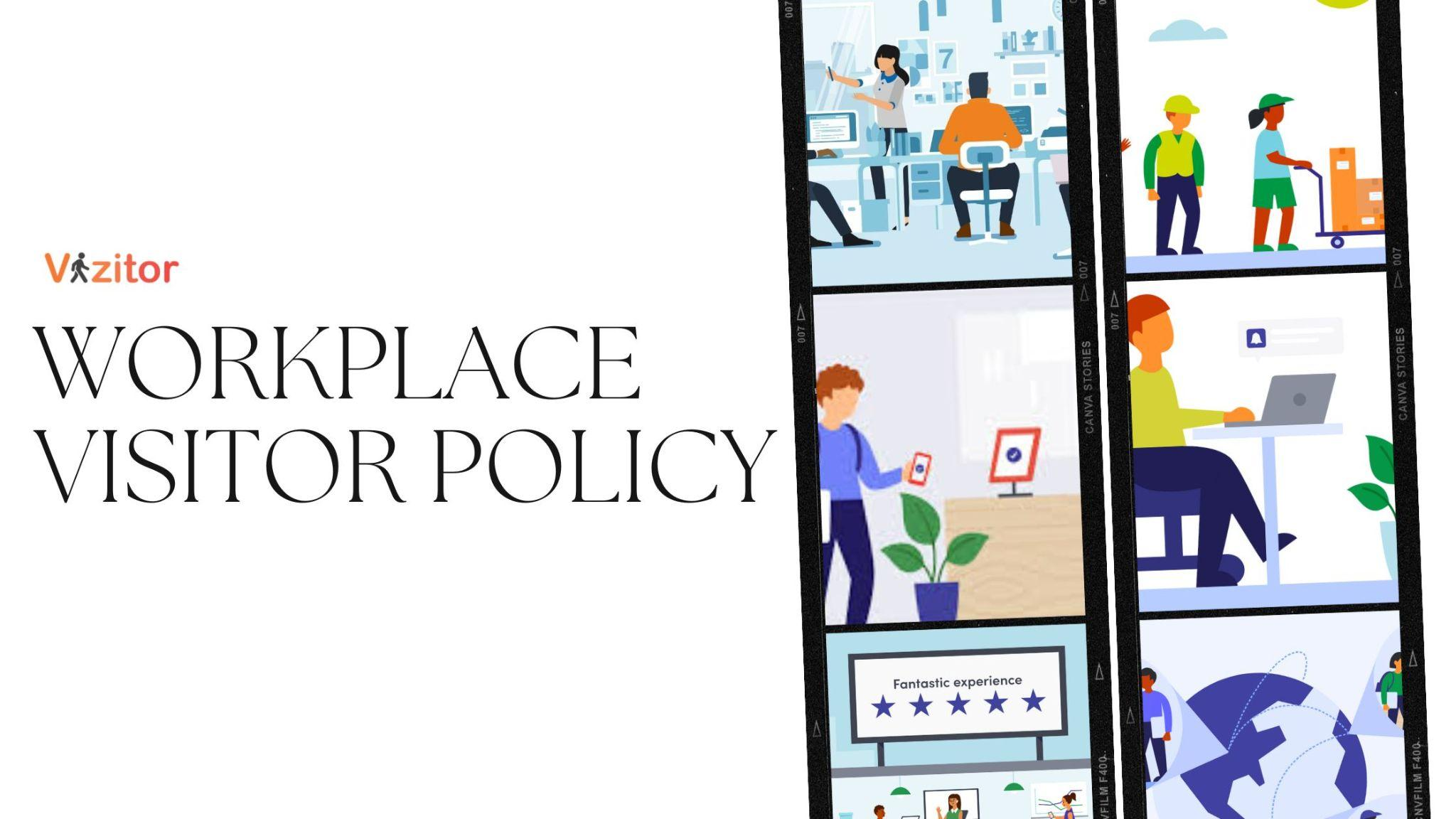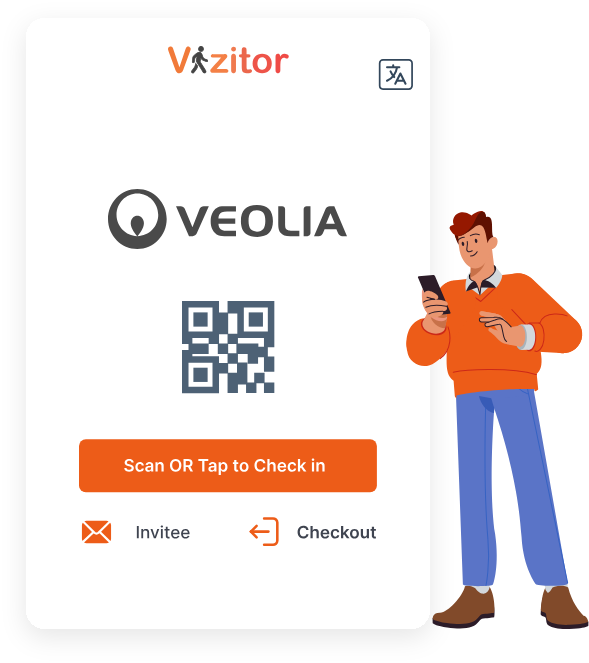Table of Content
Try Vizitor for Free!

Mon, May 27, 2024
Read in 9 minutes
Did you know that over 80% of companies now have a formal workplace visitor policy in place? This significant percentage underscores the growing recognition of the importance of managing visitors effectively. Companies adopt these policies to enhance security, protect sensitive information, and ensure a safe and organized environment for both employees and visitors.
The policy outlines the protocols and procedures for managing guests, including check-in processes, visitor identification, and access control measures. By implementing a robust visitor policy, companies can minimize risks, streamline operations, and create a professional and welcoming atmosphere. This guide will walk you through the key elements of crafting an effective policy tailored to your organization’s unique needs.
What Is A Workplace Visitor Policy?

It is a set of guidelines and procedures established by an organization to manage the entry, presence, and exit of visitors within its premises. This policy aims to ensure the safety and security of employees, protect sensitive information, and maintain an organized and professional environment.
It typically includes protocols for visitor registration, identification, and access control, as well as rules regarding the behavior and movement of visitors while on-site. By clearly defining these procedures, a Workplace Visitor Policy helps mitigate potential risks, enhances operational efficiency, and promotes a positive experience for both visitors and employees.
Why Does Every Workplace Need a Visitor Policy?
Every office needs a Workplace Visitor Policy to ensure security, safety, and operational efficiency. With increasing concerns about unauthorized access, data breaches, and workplace safety, a visitor policy provides a structured approach to managing guests. It helps protect sensitive information, maintain a professional environment, and comply with legal regulations. By implementing a visitor policy, companies can mitigate risks, enhance their security protocols, and ensure a seamless experience for both employees and visitors.
1. Security: A visitor security helps protect the workplace from unauthorized access, ensuring that only approved individuals can enter. This reduces the risk of theft, espionage, and other security breaches.
2. Safety: By monitoring and controlling visitor access, workplaces can maintain a safe environment for employees. This is particularly important in industries where safety protocols must be strictly followed to prevent accidents and injuries.
3. Confidentiality: In many workplaces, sensitive information must be safeguarded. A visitor policy helps ensure that confidential data and proprietary information remain secure by restricting access to areas where such information is stored or discussed.
4. Compliance: Many industries are subject to regulations that require the monitoring and documentation of visitors. A visitor policy helps companies comply with these legal requirements, avoiding potential fines and legal issues.
5. Professionalism: A well-implemented visitor policy contributes to a professional and organized workplace environment. It ensures that visitors are greeted and managed consistently, reflecting positively on the company’s image.
6. Operational Efficiency: By streamlining the check-in and check-out processes, a visitor policy minimizes disruptions and helps maintain smooth operations. It ensures that employees are aware of who is on the premises and can manage their interactions with visitors effectively.
7. Emergency Management: In the event of an emergency, having a visitor policy in place helps ensure that all visitors are accounted for and can be evacuated safely. This improves overall emergency preparedness and response.
Key Elements of a Workplace Visitor Policy
Creating an effective Visitor Office Policy involves incorporating several key elements to ensure comprehensive management and security. Here are the crucial components:
1. Purpose and Scope
• Purpose: Clearly state the objectives of the visitor policy, such as enhancing security, ensuring safety, and maintaining confidentiality.
• Scope: Define who the policy applies to, including all visitors, contractors, and vendors, as well as any specific areas of the workplace it covers.
2. Visitor Identification and Registration
• Pre-registration: Outline procedures for pre-registering visitors, including necessary information and documentation.
• On-site Registration: Specify the process for on-site registration, such as signing in at the reception or using a digital visitor management system.
• Identification Badges: Require visitors to wear identification badges at all times while on the premises, clearly indicating their visitor status and access level.
3. Access Control
• Restricted Areas: Identify areas that are off-limits to visitors and ensure access is granted only to authorized personnel.
• Escorting Visitors: Establish guidelines for escorting visitors, especially in sensitive or secure areas.
4. Visitor Conduct
• Behavioural Expectations: Define acceptable behaviour for visitors, including adherence to workplace rules and respect for employees and property.
• Prohibited Items: List any items that visitors are not allowed to bring onto the premises, such as weapons, alcohol, or unauthorized electronic devices.
5. Confidentiality and Data Protection
• Non-disclosure Agreements: If necessary, require visitors to sign non-disclosure agreements to protect sensitive information.
• Data Security: Implement measures to ensure that visitors do not have unauthorized access to confidential information, including digital and physical data.
6. Emergency Procedures
• Evacuation Protocols: Include visitors in the workplace’s emergency evacuation plans and ensure they are aware of the procedures.
• Emergency Contacts: Maintain a list of emergency contacts for visitors in case of an incident.
7. Health and Safety Requirements
• Health Checks: If applicable, outline any health screening procedures for visitors, such as temperature checks or health questionnaires.
• Personal Protective Equipment (PPE): Specify any PPE requirements for visitors, particularly in areas where safety is a concern.
8. Visitor Departure
• Check-out Process: Establish a formal check-out process for visitors to follow when leaving the premises, including returning identification badges.
• Post-visit Review: Implement procedures for reviewing and documenting any incidents or issues that occurred during the visit.
9. Training and Communication
• Employee Training: Ensure that employees are trained on the visitor policy and understand their roles and responsibilities.
• Visitor Communication: Provide clear information to visitors about the policy before and upon arrival, including signage and verbal instructions.
10. Policy Review and Updates
• Regular Review: Schedule regular reviews of the visitor policy to ensure it remains effective and up-to-date with any changes in the workplace or regulatory requirements.
• Feedback Mechanism: Establish a mechanism for receiving and incorporating feedback from employees and visitors to improve the policy.
Choose Vizitor For Your Workplace Visitor Policy.

Selecting the right visitor management system is crucial for implementing an effective workplace visitor policy. Vizitor stands out as a top choice for numerous reasons, offering comprehensive features and benefits that streamline the visitor management process, enhance security, and promote a professional environment.
1. User-Friendly Interface
Vizitor offers an intuitive and user-friendly interface, making it easy for both visitors and employees to use. The seamless check-in and check-out process reduces wait times and improves the visitor experience.
2. Enhanced Security
With Vizitor, you can ensure that your workplace remains secure. The system includes robust features such as visitor identification, pre-registration, and access control, allowing you to keep track of who is entering and exiting your premises at all times.
3. Customizable Solutions
Vizitor allows you to tailor the system to fit your specific needs. From customizing visitor badges to setting up personalized check-in processes, Vizitor provides flexibility to match your workplace requirements.
4. Compliance and Data Protection
Vizitor helps you stay compliant with industry regulations by securely storing visitor data and providing detailed audit trails. The system is designed with data protection in mind, ensuring that sensitive information is kept safe and confidential.
5. Real-Time Notifications
Stay informed with real-time notifications. Vizitor sends instant alerts to hosts when their visitors arrive, ensuring timely and efficient interactions. This feature enhances communication and reduces the chances of missed appointments or unattended guests.
6. Analytics and Reporting
Gain valuable insights into your visitor management processes with Vizitor’s comprehensive analytics and reporting tools. Track visitor trends, peak times, and other metrics to optimize your operations and improve overall efficiency.
How Vizitor Helps You

1. Streamlined Check-In Process
Vizitor’s digital check-in process eliminates the need for paper logbooks, reducing clutter and administrative burden. Visitors can quickly sign in using a tablet or smartphone, speeding up the registration process and minimizing wait times.
2. Visitor Pre-Registration
Allow visitors to pre-register before arriving at your workplace. This feature speeds up the check-in process and helps you prepare for their visit, ensuring a smoother experience for both visitors and hosts.
3. Visitor Identification and Badging
Vizitor generates custom visitor badges with essential information such as name, photo, and visit purpose. These badges enhance security by clearly identifying visitors and their access permissions.
4. Access Control Integration
Integrate Vizitor with your existing access control systems to manage visitor entry and exit seamlessly. This integration ensures that only authorized visitors can access restricted areas, enhancing overall security.
5. Emergency Management
In case of an emergency, Vizitor provides a real-time list of all visitors on-site, ensuring that everyone can be accounted for and safely evacuated. This feature enhances your workplace’s emergency preparedness and response.
6. Feedback and Improvement
Collect feedback from visitors to continuously improve their experience. Vizitor allows you to gather visitor impressions and suggestions, helping you identify areas for improvement and make necessary adjustments.
Frequently Asked Questions
1. What Is a Visitor in the Workplace?
A visitor in the workplace refers to anyone who is not an employee or regular staff member but enters the premises for various purposes. Visitors can include clients, contractors, vendors, delivery personnel, job applicants, and even friends or family members of employees. These individuals may need to meet with employees, attend meetings, deliver goods, provide services, or simply tour the facility.
2. How Do You Deal with Visitors in the Workplace?
• Pre-Registration: Encourage visitors to pre-register.
• Check-In Process: Have visitors sign in and receive a badge.
• Identification and Badging: Issue visitor badges with names and photos.
• Access Control: Restrict access to certain areas and ensure visitors are escorted.
• Visitor Conduct: Communicate expected behaviour and rules.
• Check-Out Process: Implement a formal check-out process.
• Emergency Procedures: Include visitors in emergency plans.
• Feedback: Collect feedback from visitors.
3. How to write a Workplace Visitor Policy?
• Introduction and Purpose: Explain why the policy exists.
• Scope: Define who the policy covers.
• Visitor Registration: Outline pre-registration and check-in processes.
• Access Control: Specify access restrictions and escort requirements.
v Visitor Conduct: Describe expected behaviour and rules.
• Confidentiality: Protect sensitive information.
• Emergency Procedures: Detail emergency protocols.
• Health and Safety: Specify any health requirements.
• Check-Out Process: Describe the check-out process.
• Training and Communication: Train employees and communicate the policy to visitors.
• Review and Updates: Regularly review and update the policy.










